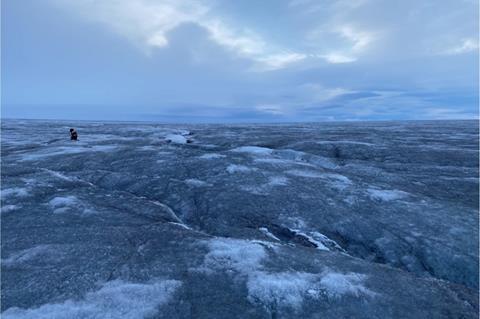The large glaciers in Greenland have long been perceived as ice deserts, but new evidence suggests there is much more life on the glaciers than previously thought.

Headed by Professor Alexandre Anesio, a group of researchers from the Department of Environmental Science at Aarhus University have discovered that the glaciers are teeming with microbes that have adapted to life on the ice.
“A small puddle of melt-water on a glacier can easily have 4,000 different species living in it. They live on bacteria, algae, viruses and microscopic fungi. It’s a whole ecosystem that we never knew existed until recently,” says Alexandre Anesio..
Black algae
One of the microorganisms on the ice that the researchers spent most time investigating is a small black algae, which grows on top of the ice and tinges it black. There is a reason why the black algae is so interesting for the researchers.
“When the ice darkens, it becomes more difficult to reflect sunlight. Instead, heat from the sun’s rays is absorbed by the ice, which starts to melt. The more the ice melts, the warmer the temperature on Earth. The algae therefore play an important role in global warming,” says Alexandre Anesio.
In recent years, larger and larger areas of the ice have become stained by the algae, making the ice melt even faster. Alexandre Anesio has calculated that the algae are increasing the ice melt by about 20 per cent.
The algae on the ice also existed before humans kicked off global warming through industrialisation. However, climate change means spring arrives ever earlier to the Arctic and as a result the algae have a longer season to grow and spread.
“The algae spread a little more every year. When I travel to Greenland, I now see vast areas where the ice is completely dark because of the algae,” he says.
Slowing it down
Alexandre Anesio and his colleagues are spending a lot of time on the black algae because they are trying to find out whether the algae growth can be slowed down in some way or another.
There is a balance In most ecosystems because the various organisms keep each other in check. So Alexandre Anesio wants to learn more about the relationship between the different microbes.
“The various microorganisms on the ice affect each other. Some leave nutrition that others live off. Small viral particles attack and consume bacteria. We believe that some of the fungal spores could eat the black algae. This is what we’re looking for,” he says.
However, he stresses that, even if they do find a way to curb algae growth, this will not solve climate change, although it could slow it down.
Black tea pigment
Algae is found virtually everywhere, in the sea, in lakes, on trees and rocks, and even as small spores in the air. Like plants and trees, most algae are green because of chlorophyll which enables them to photosynthesise.
“Because the algae live on the ice, they’re bombarded with sunlight and radiation. To protect themselves, they produce a lot of black pigment. It’s actually the same pigment as in black tea. The pigment forms a protective layer outside the algae and protects the chlorophyll molecules against the dangerous radiation,” says Alexandre Anesio.

When the pigment absorbs the sun’s rays, it generates heat. This heat makes the ice around the algae melt and this actually benefits the algae which need both water and micronutrients from the ice to live. They can only use the water when it is liquid.
NASA interest
Alexandre Anesio’s research into life on the ice is important for a better understanding of climate change. However, NASA is also following his research results closely. The results may be crucial in the hunt for life in space.
“NASA has approached us several times because we‘re working with life that lives in one of the most inhospitable places on Earth. If life thrives on and under the ice, there’s a probability that we’ll also find life in the ice on Mars or Jupiter’s and Saturn’s ice moons, for example,” he says.
Before NASA sent their Perseverance rover to Mars, they even invited Alexandre Anesio to a meeting.
“They were afraid that the rover would take with it microbes from Earth. Microbes that may be able to survive on Mars and pollute the samples they were going to take from Mars. So, they wanted to know what conditions life can survive in. What are the boundaries for life?”
Liquid oceans
NASA is so interested in the research of life in the ice because we haven’t yet found liquid water on any other planets in the solar system, but we’ve found plenty of ice.
However, there is evidence to suggest that there are liquid oceans beneath the frozen surface of Saturn’s moon, Enceladus and Jupiter’s moon, Europa – and one of the necessities of life, as we know it, is liquid water.
Therefore, NASA and other space agencies are very interested in learning more about the type of life that can live on and under the ice, because organisms resembling those in Greenland are probably what they’ll be looking for on the ice moons.
“Like us, they’re very interested in how the microorganisms on the ice function. How much nutrition do they need? What type of nutrition? And how does the ecosystem they are part of work? These are questions that we hope to be able to answer in the future,” says Alexandre Anesio.







No comments yet